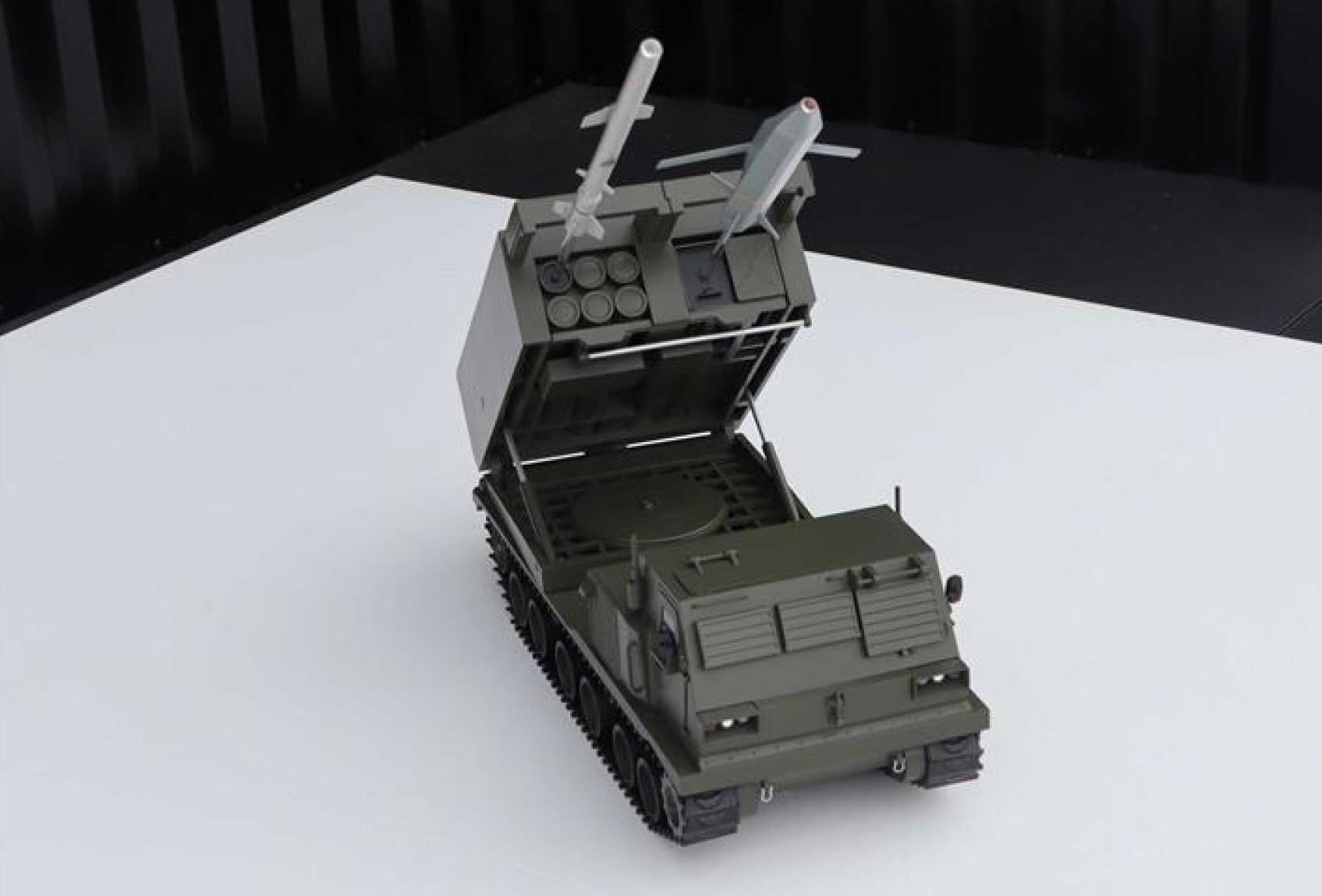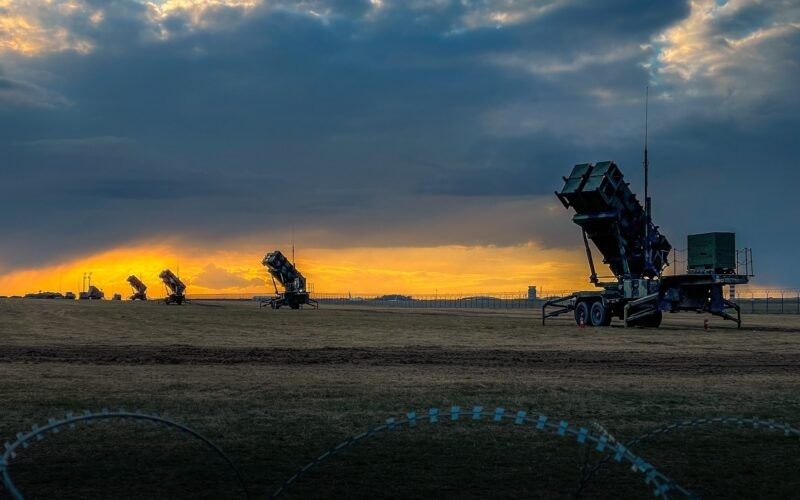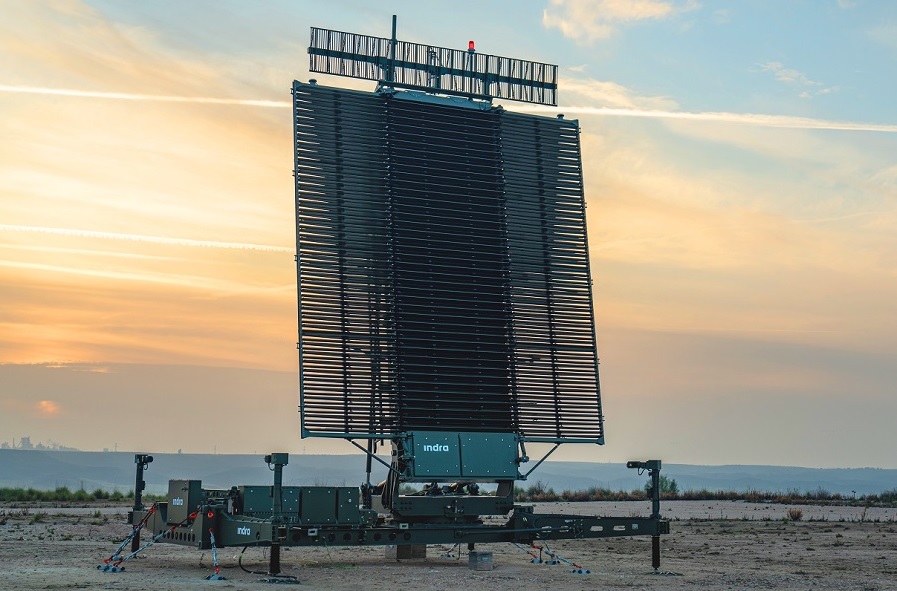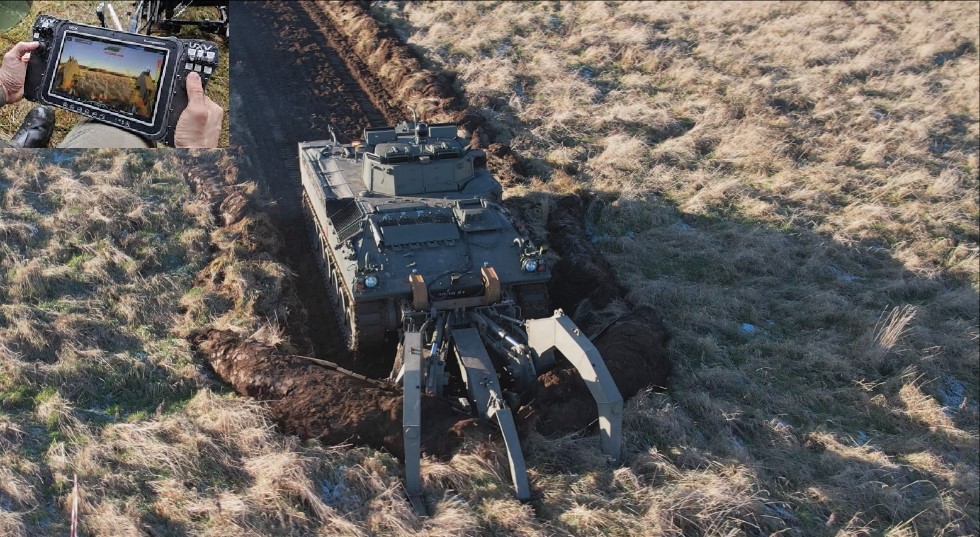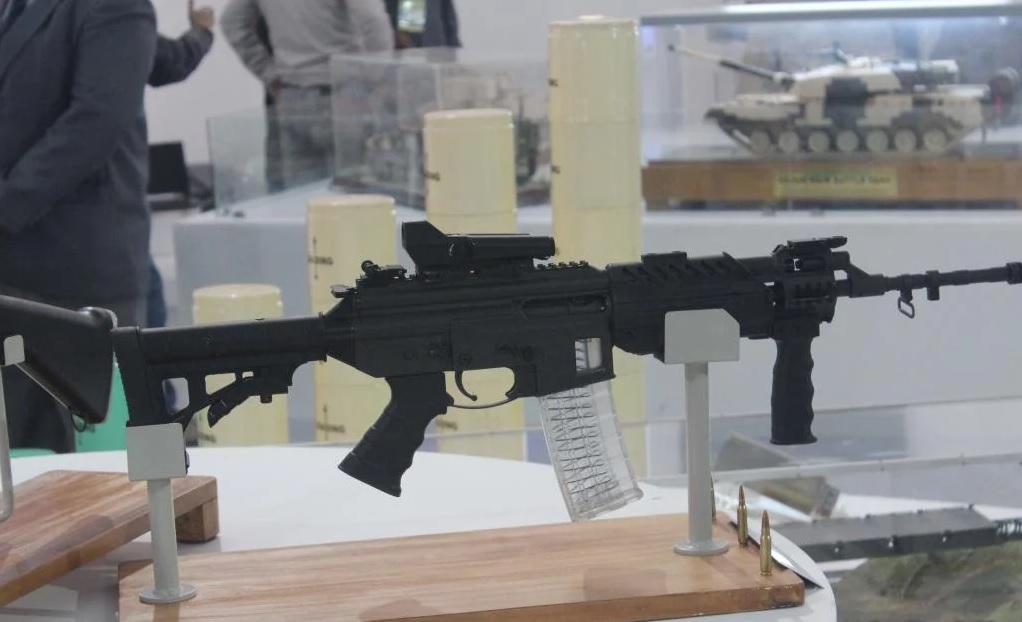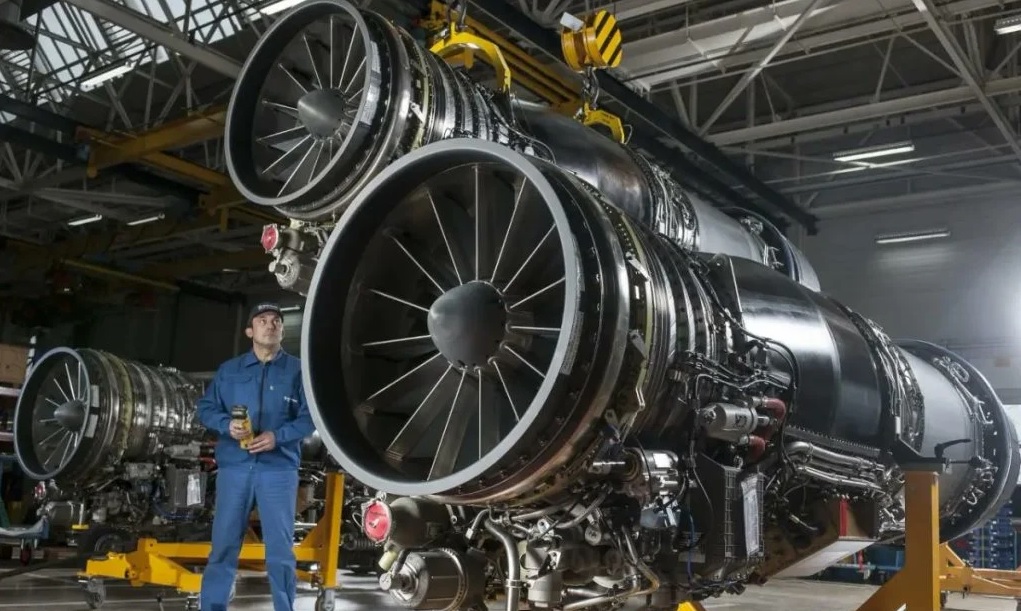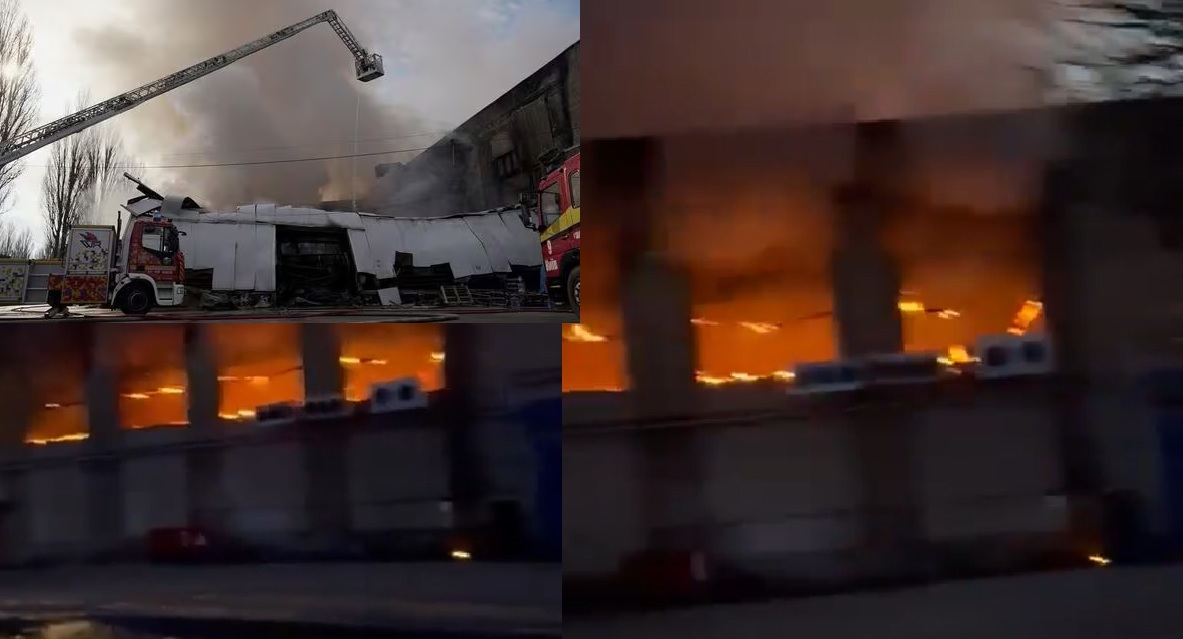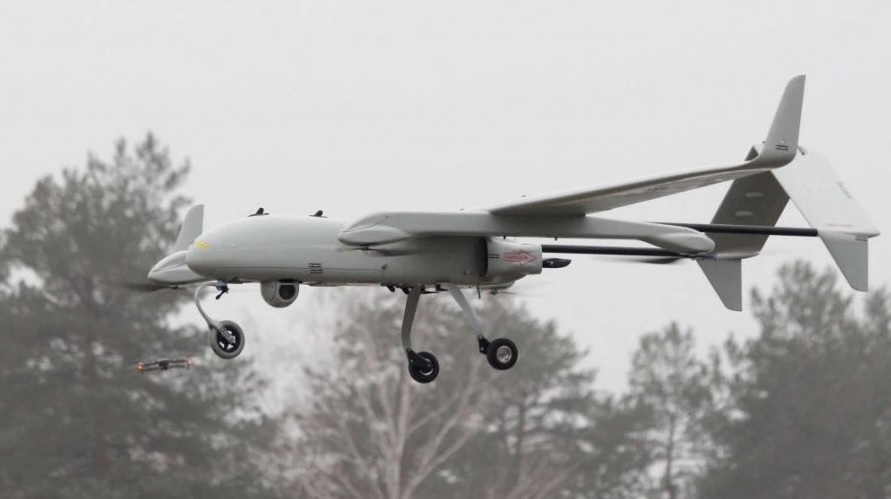World
In a case that continues to haunt India’s counterterrorism agencies, 26/11 conspirator Tahawwur Rana has once again come under the spotlight—this time for what investigators believe is a clever tactic to dodge justice. The National Investigation Agency (NIA), currently interrogating Rana following his extradition from the United States, suspects that his long list of health issues—including Parkinson’s disease and 32 other medical conditions—is being used as a smokescreen to feign memory loss and avoid answering crucial questions about the deadly 2008 Mumbai attacks. Although Rana appears frail and often claims fatigue during questioning, NIA officers believe otherwise. “He looks tired, but his mind is alert and calculating,” an official familiar with the case remarked. This belief is strengthened by how he handles legal procedures—demanding specific legal representation, asserting his rights under the U.S. Constitution, and requesting court-appointed lawyers who are not media-savvy. These, investigators argue, are not the actions of someone struggling with mental clarity. Rana’s links to the 26/11 attacks are deep and disturbing. A Pakistani-Canadian national, he is known to have collaborated with David Coleman Headley—his associate and another key plotter of the attacks. Both were accused of helping Pakistan-based terror groups and the ISI plan and execute the assault that left 166 people dead across Mumbai. The terrorists targeted iconic sites including the Taj Mahal Palace Hotel, Oberoi Trident, Nariman House, and Chhatrapati Shivaji Maharaj Terminus. One fact raising serious suspicion is Rana’s earlier travel history. NIA is closely scrutinizing his movements across India in 2008—especially his stays in Delhi, Hapur, Agra, and notably, Mumbai. He had even stayed at the Taj Hotel with his wife, Samraz Rana Akhtar, just months before it was attacked. The couple also visited Kochi and Ahmedabad, and officials are probing whether these visits were part of a reconnaissance mission for future attacks. The agency is especially interested in discovering the identity of a mysterious aide known only as “B,” who allegedly helped Rana during his India trips. Furthermore, investigators are trying to gather more details about his Indian in-laws and whether they unknowingly—or knowingly—played any role in facilitating his plans. Despite being questioned daily for about three hours, Rana has shown an unusual level of legal awareness. He invoked the Fifth Amendment of the U.S. Constitution, which protects against self-incrimination and guarantees due process. His American lawyer earlier argued against his extradition, claiming that putting him on trial again in India after being acquitted of similar charges in the U.S. would violate legal principles. Even so, Indian authorities are not buying the defense narrative. Rana is undergoing medical checkups every 48 hours, but officials remain skeptical. “There seems to be a pattern,” said a senior investigator. “The illness card is being used to slow down questioning and mask selective amnesia.” Going forward, the NIA may seek court permission to take Rana to other cities he visited in 2008. These trips could help piece together missing links—especially those related to funding channels, sleeper cells, and operational support systems embedded in India. Now 64, Tahawwur Rana’s fate may still hang in the balance, but one thing is clear: India’s security agencies are determined not to let time or tactics blur the truth behind one of the country’s most horrific terrorist attacks.
Read More → Posted on 2025-04-14 15:38:46World
In a significant leap for defence technology, Finnish telecom company Telia and defence manufacturer Patria have successfully demonstrated the remote operation of an unmanned armoured vehicle using a 5G network. The trial took place in the challenging environment of Lapland during military exercises and showcased the potential of modern communication systems in transforming how military assets can be controlled and deployed. The centre of attention was the Patria AMV XP 8x8 armoured vehicle, which was operated remotely from nearly 100 kilometres away. What made this feat possible was Telia’s use of a secure 5G network slice — a specialised part of the 5G network dedicated solely to the task. This ensured ultra-low latency, high reliability, and consistent data transmission, even when the vehicle was moving at high speeds over rugged terrain. This demonstration was part of a larger initiative called the eALLIANCE programme, which aims to drive forward digital and technological innovation within Finland’s defence sector. The five-year programme, launched in 2024 and partly funded by Business Finland, brings together more than 30 companies with a combined budget of around EUR 85 million. Patria leads the effort, focusing on future-ready defence technologies. According to Patria’s Chief Technology Officer, Matti Saarikko, the successful remote operation of a military vehicle from such a long distance marks a pivotal achievement. It opens doors for using unmanned ground vehicles in a variety of missions — including reconnaissance, support, and potentially direct combat roles — while keeping human operators out of harm’s way. Telia’s 5G Programme Director, Janne Koistinen, emphasized that this trial is a key example of how advanced 5G network slicing can extend beyond civilian industries into national defence. He pointed out that the defence sector is increasingly becoming a crucial area for dual-use technology innovation — where the same tech serves both civilian and military purposes. The results of this trial are expected to have wide-ranging implications for future battlefield strategies. Being able to control heavy armoured vehicles remotely means militaries could eventually deploy unmanned forces deep into hostile or high-risk zones, reducing the risk to personnel while maintaining operational effectiveness. With this successful test, Finland is positioning itself at the cutting edge of military technology innovation, combining home-grown defence expertise with advanced telecommunications. The experiment not only showcases the strength of collaboration between tech and defence sectors but also signals a new era where real-time, remote-controlled warfare might soon become a norm on the modern battlefield.
Read More → Posted on 2025-04-14 15:34:45World
Britain has released the second part of a major war loan to Ukraine, sending £752 million (about $990 million) to help Kyiv strengthen its air defences and artillery systems. This move is part of a larger international support package worth $50 billion, underpinned by profits generated from frozen Russian assets held in Western countries. The announcement came just a day after Russia launched a deadly missile attack on the northern Ukrainian city of Sumy, killing 34 people and injuring 117 others. British Prime Minister Keir Starmer condemned the strike, calling it “appalling” and reaffirming Britain’s support for Ukraine in its ongoing fight against Russian aggression. The £752 million disbursed on Monday is the second of three installments in a total loan of £2.26 billion from the UK to Ukraine. The first payment was made on March 6, and the third is expected to follow in 2026. The loan agreement was finalised in March by Britain’s Finance Minister Rachel Reeves and Ukraine’s Finance Minister Serhiy Marchenko, as part of a coordinated effort led by the Group of Seven (G7) nations. The G7 had initially agreed on the broader lending framework in October 2024. According to Reeves, the global security landscape is rapidly changing, and Russia’s continued aggression in Ukraine is one of the major drivers of instability. She emphasized the need for democracies to act together in the face of growing threats. As the United States appears to be reevaluating its role in European security following the election of Donald Trump, the UK has stepped up its own defence commitments. In February, Britain pledged to increase defence spending from the current 2.3% of national income to 2.5% by 2027, with a goal of reaching 3% sometime after 2029. British Defence Minister John Healey confirmed that the UK will provide £4.5 billion in total support to Ukraine this year. The funding will be used not only for air defences and artillery but also for vehicle spare parts and various battlefield equipment. Additionally, the British Ministry of Defence is helping Ukraine procure radar systems, anti-tank mines, and hundreds of thousands of drones, further strengthening Ukraine’s capabilities on the frontlines. Despite the ongoing war and the evolving political situation, public support in the UK for aiding Ukraine remains strong. Most major political parties back continued military and financial assistance, highlighting the broad consensus in Britain that Russia’s aggression must be met with a unified response. The fresh infusion of funds comes at a critical time for Ukraine as it continues to face regular missile and drone strikes from Russian forces, many of which target civilian areas. With rising tensions and the battlefield situation becoming more complex, Western support—including the kind provided by Britain—is seen as essential for Ukraine’s resilience and ability to defend its sovereignty.
Read More → Posted on 2025-04-14 15:27:43India
India’s ambitious push for indigenous aviation is steadily taking shape with the upcoming test flight of the SARAS MK-2 aircraft, now scheduled for December 2027. This 19-seater twin-engine turboprop, developed by the Council of Scientific and Industrial Research–National Aerospace Laboratories (CSIR-NAL), is designed to provide a versatile, low-cost solution for regional air travel and various utility roles. According to CSIR-NAL Director Abhay Pashilkar, the SARAS MK-2 is in the final stages of design refinement and is expected to be ready for its maiden flight by the end of 2027. The aircraft is an upgraded version of the earlier SARAS prototype, which made headlines as India's first indigenously developed civilian aircraft but was stalled after a tragic crash in 2009. The program was revived in 2016 with fresh funding and renewed interest from both government and defence sectors. The SARAS MK-2 is engineered to operate effectively from short, semi-prepared airstrips, which makes it ideal for India's remote and underdeveloped regions. With a cruising speed of 500 km/h and a maximum range of 2,450 km (when carrying seven passengers), the aircraft can play a key role in connecting small towns and cities, especially under the UDAN scheme aimed at enhancing regional air connectivity. A key backer of the program is the Indian Air Force, which has already shown intent to procure 15 units for logistical and administrative duties. The aircraft’s modular layout and ease of maintenance also make it a strong candidate for use in air ambulance services, charter operations, disaster relief missions, and even border surveillance. Technologically, SARAS MK-2 includes significant improvements over its predecessor. It comes equipped with a high-wing configuration for better stability and field performance, twin turboprop engines, and cutting-edge avionics systems supplied by Indian companies like Genesis and Paras Defence. Several critical systems, including the brake management and environmental control systems, have been developed in-house by NAL engineers. To meet certification and production timelines, CSIR-NAL plans to develop two prototypes, which will undergo rigorous testing. Hindustan Aeronautics Limited (HAL) will contribute to manufacturing specific components, while other metallic parts will be sourced from private vendors, supporting India’s growing aerospace supply chain ecosystem. One of the challenges that delayed the aircraft’s timeline—originally aimed for 2024–25—was the difficulty in sourcing certified test pilots and obtaining necessary regulatory approvals. Material procurement delays and ongoing design optimisations also played a role in pushing the schedule further. Once certified, SARAS MK-2 is expected to make a significant impact on India's civil and strategic aviation landscape. It represents a step forward not just in self-reliance but in providing cost-effective and adaptable aircraft suited for India's unique geographical and infrastructural needs. If successfully inducted and produced at scale, SARAS MK-2 could help reduce India's reliance on imported aircraft in the regional sector and offer export potential to friendly countries with similar aviation requirements.
Read More → Posted on 2025-04-14 15:23:42World
France is taking a bold step toward military self-reliance by developing its own long-range precision strike system, with the first test launch scheduled for mid-2026. The project, known as Frappe Longue Portée Terrestre (FLP-T), aims to provide a sovereign alternative to foreign systems like the American HIMARS and strengthen France’s position in the evolving landscape of modern warfare. This ambitious initiative is being led by France’s General Directorate of Armaments (DGA) and involves several top-tier defence firms such as MBDA, Thales, Safran, and ArianeGroup. Together, they are designing a tactical missile system with a projected range of up to 150 kilometers, capable of delivering high-precision strikes in deep enemy territory. Key Specifications and Features Maximum Range: Up to 150 km Guidance System: Likely to feature advanced GPS/INS (Inertial Navigation System) with potential for satellite-linked targeting Platform Type: Truck-mounted Multiple Launch Rocket System (MLRS) Payload Options: High-explosive warheads, submunitions, or guided precision munitions Mobility: Designed for rapid deployment and high mobility across diverse terrains The FLP-T programme has received a funding commitment of €600 million under France’s 2024–2030 defence budget. This investment will support the acquisition of at least 13 new rocket launchers by 2030, with plans to increase the fleet to 26 units by 2035. These systems will gradually replace France’s outdated MLRS platforms, many of which no longer meet the requirements of modern battlefield conditions. Strengthening European Defence Autonomy For years, European countries have relied on non-EU systems such as U.S.-made HIMARS, Israel’s PULS, and South Korea’s Chunmoo to strengthen their long-range artillery capabilities. France’s initiative stands out as it seeks to fill a critical gap by introducing a European-made system that can compete with or even outperform foreign alternatives. By investing in the FLP-T, France is not only reinforcing its own defence capabilities but also contributing to European strategic autonomy. A successful domestic long-range strike system could encourage other EU member states to follow suit, potentially reducing Europe’s dependence on external suppliers for high-end military technologies. A New Chapter for French Artillery The upcoming 2026 test will be a major milestone in France’s journey toward re-establishing itself as a leader in advanced rocket artillery. The development of the FLP-T system reflects a broader strategy to modernize the French Army, promote industrial innovation, and ensure the country can independently conduct deep-strike missions in high-intensity conflict scenarios. As the global security landscape continues to evolve, France’s determination to build and deploy its own precision strike system highlights a clear shift toward defence sovereignty—and may serve as a blueprint for others across Europe to follow.
Read More → Posted on 2025-04-14 15:19:59World
Ukrainian President Volodymyr Zelenskyy has made a bold and urgent plea to the United States, stating that Ukraine is ready to spend $15 billion to acquire 10 Patriot missile defense systems. These systems are crucial for protecting Ukrainian cities and infrastructure from ongoing Russian missile and drone attacks. Speaking in an interview with the U.S. television program "60 Minutes," Zelenskyy expressed frustration that, despite commitments made during the recent NATO summit in Washington, Kyiv still hasn’t received the additional Patriot systems it was expecting. Highlighting Ukraine’s dire need for enhanced air defenses, Zelenskyy said, “We are ready to pay these $15 billion. We will find this money and cover all the costs.” The Patriot air defense system, developed by Raytheon, is considered one of the most advanced surface-to-air missile systems in the world. It can intercept both cruise and ballistic missiles as well as aircraft. For Ukraine, which is under constant bombardment by Russian missile strikes, the Patriots are not just a military asset — they’re a matter of national survival. Zelenskyy noted that Ukraine has already made several proposals to the U.S., including options to buy, lease, or even produce the systems under license. So far, however, the U.S. has not approved any of these ideas. Zelenskyy pointed out that the U.S. is currently selling Patriot systems to other countries, such as Israel, and questioned why the same could not be done for Ukraine. “I’m not saying Israel doesn’t need them,” he said, “but if we are partners, can’t a way be found to protect Ukraine?” In response to the delays, Zelenskyy shared that some European nations have shown interest in co-financing the deal, provided the U.S. is willing to move forward with it. But the window of opportunity is narrowing as Russia ramps up its aerial assaults, targeting everything from power stations to civilian infrastructure. Beyond financial and diplomatic efforts, Zelenskyy extended an invitation to former U.S. President Donald Trump, urging him to visit Ukraine and see firsthand the destruction inflicted by Russian forces. Zelenskyy also revealed that he has made similar license production requests during both the Trump and Biden administrations, as Ukraine seeks a longer-term solution for its defense needs. However, political tensions in the U.S. may complicate matters. After the “60 Minutes” episode aired, which featured Zelenskyy’s interview and a segment from Greenland, Trump criticized the network for what he called unfair coverage and urged penalties against the broadcaster. This media clash risks overshadowing Ukraine’s urgent appeal. Despite these hurdles, Zelenskyy remains firm. “If we want to survive and defend our people, we must act,” he said. His message to Washington is clear: Ukraine is willing to pay the price — financially and diplomatically — but it cannot wait forever. As the war drags on and winter approaches, Kyiv is racing against time. The Patriot systems could be a game-changer in defending Ukrainian skies. Whether the U.S. responds positively may determine how many lives and critical facilities Ukraine can still protect in the months ahead.
Read More → Posted on 2025-04-14 15:19:29World
In a significant new step to strengthen Ukraine’s battlefield edge, a group of Western allies led by Germany has announced the formation of an Electromagnetic Coalition to support Kyiv in the ongoing war against Russia. This initiative, involving Germany and nine other partner nations, aims to help Ukraine dominate the electromagnetic spectrum—a critical but often unseen dimension of modern warfare. This coalition is the ninth such international grouping created in support of Ukraine, following earlier ones focused on artillery, fighter jets, air defense, demining, and more. Each coalition addresses a different aspect of military needs, and this latest one centers on the fast-evolving and strategic area of electronic warfare (EW). A New Front in the War: Electronic Dominance The primary goal of the Electromagnetic Coalition is to secure Ukraine’s advantage in the electromagnetic space—which includes radio frequencies used for communications, drones, radar, and navigation systems. Control over this domain is essential for modern combat, especially in an era where drones, jammers, and signal interception can turn the tide of battle. The coalition’s objectives include: Protecting friendly communications from enemy interference or jamming Disrupting Russian electronic systems, including command and control Enhancing drone operations, which rely heavily on stable electromagnetic signals Ensuring the reliability and precision of Ukraine’s weapon systems This effort will not only address Ukraine’s immediate operational needs but will also support long-term development of national electronic warfare capabilities. It marks a strategic shift, recognizing that the war in Ukraine is also a testing ground for future combat technologies. Coordination, Training, and Procurement Beyond battlefield operations, the Electromagnetic Coalition also focuses on the administrative and policy side of warfare. Member nations will work together to streamline procurement of advanced EW equipment, organize training programs for Ukrainian forces, and shape long-term policies to keep Ukraine ahead in this technological domain. Germany, which is spearheading the initiative, sees this not only as a way to help Ukraine but also as a chance to learn from real-time battlefield lessons and integrate them into its own military modernization plans. Germany’s Financial and Military Commitment In addition to its leadership in the coalition, Germany has stepped up its overall military support for Ukraine with a massive new funding package. The German government recently pledged €11 billion (approx. $12.5 billion) in military aid to Ukraine through 2029. For 2025 alone, €3 billion ($3.4 billion) has been allocated. The aid package includes a wide range of critical weapon systems and defense technology: 4 IRIS-T air defense systems 30 Patriot guided missiles 15 Leopard 1A5 main battle tanks 14 modern artillery systems 300 reconnaissance drones 100 ground surveillance radars German Defence Minister Boris Pistorius emphasized the importance of a strong Ukraine, stating, “We need a militarily strong Ukraine. Only then can the negotiation process lead to a lasting and just peace solution.” A Future-Oriented Strategy This coalition reflects how modern warfare is shifting—not just towards bigger guns and tanks but also towards invisible wars of signals, jamming, and precision targeting. Ukraine has proven resilient in adapting to such challenges, and the support from its Western allies is helping transform its military into one of the most technologically advanced in the region. With the Electromagnetic Coalition now in motion, Ukraine is better positioned to defend its skies, outmaneuver electronic threats, and secure vital communication lines—not only for today’s war but for the security challenges of the future.
Read More → Posted on 2025-04-14 15:15:52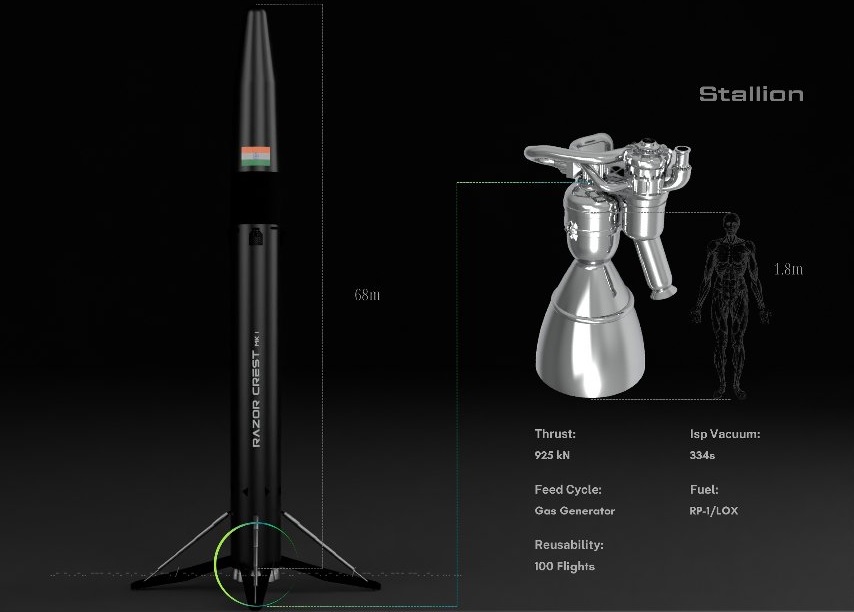
Bangalore’s EtherealX Unveils Razor Crest MK-1 — The World’s First Fully Reusable Medium-Lift Rocket
India
In a groundbreaking leap for India’s space ambitions, Bangalore-based start-up EtherealX has introduced the Razor Crest MK-1, the world’s first fully reusable medium-lift launch vehicle. This next-generation rocket is poised to set a new benchmark in space transportation, combining raw power with unmatched efficiency and reusability. At the heart of the Razor Crest MK-1 lies a powerhouse—nine Stallion engines, each generating 925 kilonewtons (kN) of thrust. Altogether, these engines deliver a total thrust that rivals some of the most advanced rockets in existence today. Designed using RP-1 and liquid oxygen (LOX) in a closed gas generator cycle, the Stallion engines are built for high-performance across both atmospheric and vacuum conditions. This design not only enhances mission flexibility but also makes reusability more feasible and cost-effective. In terms of payload capacity, the Razor Crest MK-1 is nothing short of impressive. It can launch up to 24.8 tons to Low Earth Orbit (LEO) in an expendable configuration, 22.8 tons in a partially reusable mode, and 8 tons in its fully reusable form. Beyond that, it can deliver 10.8 tons to Geostationary Transfer Orbit (GTO) and 6.8 tons to Lunar Orbit—figures that place it firmly among elite global launch vehicles. But what truly sets Razor Crest MK-1 apart is its full reusability. While many rockets can be partially recovered, EtherealX has engineered the MK-1 to return and relaunch its core stages, much like SpaceX’s Falcon 9 but tailored to meet the unique demands of both Indian and global markets. This innovation is expected to cut launch costs by up to 45%, opening up affordable access to space for commercial satellite operators, academic institutions, and governments alike. EtherealX was founded in 2022 by a dynamic trio—Manu J Nair (CEO), Shubhayu Sardar (COO), and Prashant Sharma (CTO). With strong technical backgrounds and a shared vision of transforming India into a global space leader, they’ve quickly drawn the attention of investors and space enthusiasts worldwide. The company has already secured $5 million in seed funding to accelerate development and testing of its core technologies. Their focus now lies on completing full-scale testing facilities, qualifying their engines for operational use, and preparing the MK-1 for its debut flights. The rocket is also being eyed for future human spaceflight missions, satellite deployments, and in-space services, making it a versatile platform with long-term utility. The Razor Crest MK-1 not only showcases India’s growing technological prowess but also signals a shift toward more sustainable, cost-efficient space travel. As countries and companies race to dominate the new space economy, EtherealX’s innovation could play a pivotal role in democratizing space access for all. With its bold vision, strong leadership, and revolutionary technology, EtherealX is no longer just a start-up to watch—it’s a trailblazer rewriting the future of space exploration.
Read More → Posted on 2025-04-14 15:12:03World
In a significant boost to its air defence capabilities, the Royal Air Force of Oman (RAFO) has signed a contract with leading Spanish technology company Indra for the supply of long-range Lanza 3D early warning radars. This agreement marks another milestone in the growing defence cooperation between Oman and Indra. The contract was formalised at Indra’s headquarters in Spain, where Dr. Mohamed Bin Nasser Al-Zaabi, Secretary General of Oman’s Ministry of Defence, and Ángel Escribano, Chairman of Indra Group, officially signed the deal. What the Contract Includes Under the agreement, Indra will design, deliver, and install Lanza 3D-LRR (Long Range Radar) systems at fixed locations across Oman. These advanced radars are paired with radio voice communication systems and will be fully integrated into Oman’s existing command and control infrastructure, also provided by Indra. Additionally, the project includes a crucial capability-building component — the Royal Air Force of Oman will gain the ability to perform third-level radar maintenance independently. This not only increases the nation’s operational autonomy but also ensures the long-term sustainability of its radar network. About the Lanza 3D-LRR Radar System Indra’s Lanza 3D-LRR radar is a state-of-the-art system that offers long-range air surveillance, early threat detection, and tracking of multiple aerial targets simultaneously. Key specifications include: Range: Over 450 km (approximate) Coverage: Full 360° azimuth and 3D tracking capability Target Detection: Able to track fast-moving fighter jets, helicopters, drones, and even low-observable (stealth) targets Technology: Incorporates Gallium Nitride (GaN) technology for enhanced reliability and performance Mobility: Although primarily fixed-site in this contract, Lanza radars are also available in transportable configurations Resilience: Equipped with electronic counter-countermeasures (ECCM) for operation in heavily contested environments Enhancing Oman's Defence Capabilities This new procurement complements the previous deployment of Lanza-based air defence systems in Oman, completed in 2020. It represents a natural expansion of Oman’s radar network and further reinforces the country’s early warning and airspace control capabilities. Oman’s decision to continue its partnership with Indra highlights its confidence in the company’s cutting-edge technology and reliable performance. Indra emphasized that Oman’s continued trust reflects their commitment to delivering customised and effective solutions for complex defence needs. Strategic Importance for Indra For Indra, this contract aligns with its broader strategy to expand operations in the Middle East defence market. Since establishing a local presence in Oman in 2010, Indra has built a team of 30 professionals and played a key role in modernizing the nation’s defence infrastructure. This new agreement not only solidifies Indra’s footprint in Oman but also positions the company as a key regional player in air surveillance technology. As global airspace becomes increasingly contested and unpredictable, investments like these ensure that nations like Oman are well-equipped to detect, track, and respond to aerial threats swiftly and effectively.
Read More → Posted on 2025-04-14 15:08:11World
The British Army has taken a major step toward improving battlefield safety with the introduction of a new robotic mine-clearing system called the “Weevil.” This advanced machine is designed to safely and efficiently clear landmines and explosive devices without putting soldiers' lives at risk. What Is the Weevil? The Weevil is a remote-controlled robotic machine developed through a partnership between the Defence Science and Technology Laboratory (Dstl) and Pearson Engineering Ltd, a British defense company. It is built to be mounted onto military vehicles and is used to push aside or excavate mines, creating safe paths for soldiers during combat missions. How It Works The Weevil system currently uses the Warrior infantry fighting vehicle as a prototype platform. This vehicle is equipped with: A full-width mine plough for clearing explosives in its path. High-definition vehicle-mounted cameras for real-time visuals. Beacon Remote Control System developed by Pearson Engineering, allowing a single operator to control the system from several miles away. This system can be adapted to work with other military vehicles, making it highly versatile and practical for different combat scenarios. Why It Matters Until now, mine-clearing operations often involved the use of the Trojan armored vehicle, which requires a three-person crew to be present in dangerous areas. This exposed soldiers to serious risks from hidden mines and improvised explosive devices (IEDs). The Weevil changes that by allowing the job to be done remotely. As Major Andrew Maggs from Dstl noted, enhancing existing military vehicles with modern robotic features maximizes their utility and increases safety, especially in high-risk missions where time is limited and the environment is hazardous. Successful Trials and the Road Ahead The Weevil was successfully tested in Newcastle and showed great promise. It will now undergo further evaluations by the British Army. These trials will help gather crucial information on how the system performs under different battlefield conditions. According to Armed Forces Minister Luke Pollard, this new technology is a game-changer. He stated that, “It won’t be a moment too soon when we no longer have to send our people directly into harm’s way to clear minefields.” Key Specifications of the Weevil System Platform: Currently uses Warrior Infantry Fighting Vehicle Attachment: Full-width mine plough Control System: Beacon Remote Control (Pearson Engineering) Operation Range: Several miles via remote control Vision System: Onboard cameras for visual feedback Crew Requirement: Single remote operator (no crew inside vehicle) Adaptability: Can be installed on different vehicle platforms Final Thoughts The Weevil is more than just a robot — it represents a safer future for soldiers and a smarter way to deal with one of the deadliest threats on the battlefield: landmines. With continued testing and improvements, the British Army is set to revolutionize how it handles mine-clearing missions, turning a once high-risk task into a safer, remote-controlled operation.
Read More → Posted on 2025-04-14 15:05:16India
India’s defence modernization drive has received a fresh boost with the unveiling of a brand-new 6.8mm assault rifle prototype developed by the Defence Research and Development Organisation (DRDO). Showcased in early 2025, this indigenously designed weapon could potentially challenge existing imports like the SIG716 and even threaten to replace the much-delayed AK-203 joint venture project with Russia. Developed by the Armament Research and Development Establishment (ARDE), the DRDO's Pune-based lab, the rifle is chambered for a unique 6.8x43mm intermediate cartridge—positioning it as a middle-ground alternative to the Indian Army's current assortment of small arms. The round itself promises a balance between the raw stopping power of the 7.62x39mm (used in AK-type rifles) and the lightweight handling of the 5.56x45mm, offering an efficient blend of lethality and manageability. Visually, the prototype presents a modern, combat-ready appearance. It features a lightweight yet durable 30-round polymer magazine reinforced with metal for enhanced strength, and an adjustable telescopic stock that allows soldiers to customize the fit according to operational scenarios. These features make the rifle suitable for everything from urban warfare to high-altitude combat along the nation’s northern borders. What makes this rifle even more compelling is its intent. Unlike DRDO’s previously launched 7.62x51mm 'Ugram' rifle that leaned towards heavier firepower, the 6.8mm prototype seeks to provide optimized performance—manageable recoil, lighter carry weight, and enhanced terminal effects—especially vital for infantry soldiers in prolonged engagements. Globally, this concept is not entirely new. The U.S. Army, for instance, recently moved to a 6.8mm round in its Next Generation Squad Weapon (NGSW) program to counter modern ballistic protection systems. India’s 6.8x43mm rifle seems to be following that same philosophy—striking the “sweet spot” between firepower and functionality. The timing of this development is also notable. The Indian Army has long been seeking a replacement for its aging INSAS rifles, which have been in service since the 1990s. Though 72,000 SIG716 rifles were acquired in 2020 as an interim measure and the AK-203 was slated for local production, neither solution has fully met the Army’s long-term needs—either due to logistical constraints or geopolitical delays. The DRDO's 6.8mm rifle could fill this gap. If fielded widely, it would not only reduce reliance on foreign arms but also align with the government’s ‘Aatmanirbhar Bharat’ initiative by bringing small arms production fully under Indian control. Furthermore, the indigenous nature of the weapon allows for easier upgrades, customizations, and localized maintenance. Still, many hurdles remain. The rifle must undergo rigorous internal testing by ARDE followed by extensive trials by the Indian Army across extreme weather zones—from the icy heights of Ladakh to the deserts of Rajasthan. Only after proving its reliability, accuracy, and endurance under these varied conditions can it be considered for mass induction. Another significant consideration is ammunition. Introducing a new 6.8x43mm caliber would require India to establish a parallel ammunition production and distribution infrastructure, which adds to the project’s logistical complexity. Training soldiers to adapt to the new weapon and recalibrating support systems like sights, cleaning kits, and magazines will also take time and resources. Despite these challenges, the introduction of this indigenous assault rifle prototype is a promising step. It not only reflects India’s maturing defence R&D capabilities but also signals a future where the country could standardize a versatile, locally made firearm for its armed forces. With global trends moving toward intermediate calibers that outperform traditional rounds, the DRDO’s 6.8mm weapon may just offer the balance the Indian Army has long sought—between firepower, portability, and battlefield adaptability. If successful in trials and adopted for large-scale induction, this rifle might not only replace aging INSAS systems but also mark the beginning of India’s next-generation small arms era.
Read More → Posted on 2025-04-14 15:00:59
Gravitics Secures $60 Million Boost from U.S. Space Force to Develop Next-Gen Orbital Carrier System
Space & Technology
In a major development for future space operations, U.S.-based space tech company Gravitics has been selected by the United States Space Force to receive up to $60 million in funding through the Strategic Funding Increase (STRATFI) initiative. This investment will support the development of Gravitics’ advanced Orbital Carrier, a platform designed to revolutionize how space missions are conducted. At its core, the Orbital Carrier is a space-based infrastructure system meant to pre-position space vehicles in orbit, allowing for rapid deployment without waiting for a launch from Earth. This approach drastically cuts down the time needed to respond to potential threats or opportunities in space and gives the U.S. Space Force a powerful new tool in its effort to maintain a technological edge. Gravitics CEO Colin Doughan described the Orbital Carrier as a “game-changer,” comparing it to a floating launch pad in space that can deploy vehicles quickly, whenever and wherever needed. This agility is increasingly important as the space domain becomes more contested and dynamic, with global powers investing heavily in both civilian and military space assets. One of the key advantages of the Orbital Carrier is its on-demand orbital flexibility. Instead of relying on fixed launch schedules and predetermined orbits, military operators will be able to choose deployment points as the mission demands, improving strategic response times and adaptability in space operations. This capability fits directly into the U.S. Space Force’s evolving strategy, which now puts a strong emphasis on tactically responsive space systems—technologies that can adapt to changing mission requirements in real time. The funding comes through SpaceWERX, the innovation arm of the Space Force that runs the STRATFI program. STRATFI is designed to speed up the transition of innovative small business technologies from research and development to operational use. Gravitics’ selection is a vote of confidence in the company’s ability to deliver a platform that fits the Space Force’s long-term vision. In addition to government funding, the Orbital Carrier project is supported by SBIR (Small Business Innovation Research) grants and private capital, forming a solid financial base for rapid technological advancement. The combination of these resources means the system could become operationally viable within the next few years, positioning Gravitics as a key player in the defense space sector. As the global space race heats up, technologies like the Orbital Carrier signal a shift in how nations will prepare and project power in orbit. Instead of building satellites and launching them reactively, future missions may rely on pre-positioned platforms ready to act at a moment’s notice. This initiative not only strengthens America’s space infrastructure but also opens the door for future commercial uses, including satellite servicing, debris removal, and modular space station construction. With the Space Force’s backing, Gravitics is now on a fast track to reshape the future of orbital logistics and defense.
Read More → Posted on 2025-04-13 15:47:00World
In a rare development, Iran and the United States have resumed indirect nuclear talks after a long freeze, signaling a potential thaw in one of the world’s most strained diplomatic relationships. The discussions, mediated by Oman, are being described by both sides as “constructive” and focused strictly on two issues: Iran’s nuclear program and the lifting of US-imposed economic sanctions. The meeting, which took place last Saturday in Muscat, marked the highest-level contact between the two countries since the collapse of the 2015 nuclear agreement. Iranian Foreign Minister Abbas Araghchi and US Middle East envoy Steve Witkoff led the discussions, which included a brief face-to-face exchange—an unusual moment in otherwise indirect negotiations. Iran’s foreign ministry clarified that these negotiations will remain indirect and will not touch upon any non-nuclear topics. “We will not have any talks with the American side on any other issue,” said spokesman Esmaeil Baqaei in a televised interview, underscoring Tehran’s firm stance. This position comes as some observers had expected the US to widen the scope of talks to include Iran’s ballistic missile program and its support for militant groups across the region. But Tehran has made it clear: only nuclear and sanction-related matters are on the table. The backdrop to these talks is a tense and complex geopolitical landscape. Iran, feeling the economic pressure of crippling sanctions and facing regional strain due to Israel’s military actions against its allies in Lebanon and Gaza, appears to be seeking relief through diplomacy—without conceding on other fronts. Interestingly, the talks come after former US President Donald Trump, now a prominent political figure again, sent a message to Iran’s Supreme Leader Ayatollah Ali Khamenei. The letter reportedly offered negotiations while warning of possible military consequences should Iran refuse. Trump’s 2018 withdrawal from the 2015 nuclear deal and his “maximum pressure” strategy of renewed sanctions had derailed years of diplomacy, causing Iran to gradually step back from its own commitments under the agreement. Despite that rocky history, this latest round of talks seems to be happening in a more measured environment. Omani Foreign Minister Badr Albusaidi described the meeting as taking place in a “friendly atmosphere,” and both countries are set to return to the negotiating table on April 19. The talks have stirred reactions across Iran’s media landscape. Conservative outlets praised the US for not pushing non-nuclear topics, while reformist newspapers called the dialogue a “decisive turning point.” Even traditionally skeptical voices acknowledged the value of avoiding threats of dismantling Iran’s nuclear program or launching military attacks. There are some immediate signs that markets are responding positively. Iran’s national currency, the rial, strengthened noticeably after the news broke—dropping from over one million rials to around 850,000 per US dollar, suggesting that traders are cautiously optimistic about the potential easing of sanctions. From a broader perspective, these talks may serve as a key moment for both nations. For Iran, it’s a chance to revive its economy while standing firm on its regional policies. For the US, it’s an opportunity to curb Iran’s nuclear ambitions without expanding military involvement in the Middle East. While skepticism lingers—especially given Trump’s unpredictable role and the absence of formal diplomatic ties between the two countries since 1979—this new phase of indirect negotiations might just offer a fragile, yet significant, opening for progress.
Read More → Posted on 2025-04-13 15:44:18India
India’s defence aerospace journey has taken a major leap forward with a significant announcement from the Gas Turbine Research Establishment (GTRE), a key laboratory under the Defence Research and Development Organisation (DRDO). GTRE has confirmed that the 110kN thrust-class engine, being developed for India’s next-generation Advanced Medium Combat Aircraft (AMCA), will feature a core architecture designed for future upgradability. This not only meets the immediate needs of the AMCA program but also opens the door for the development of more powerful engines in the 125kN to 145kN thrust range—potentially powering India’s future sixth-generation fighter aircraft. The 110kN engine is critical to the AMCA program, which aims to produce India’s first indigenously developed fifth-generation stealth fighter. While initial prototypes will use the 98kN General Electric F414 engine, India’s long-term ambition is self-reliance, and the transition to an indigenous engine is a pivotal part of that vision. The GTRE’s goal is to have the 110kN engine ready by the early 2030s, just in time for AMCA’s production phase. What makes this engine particularly forward-looking is its modular and scalable core. GTRE officials have emphasized that the architecture is being developed with “core upgradeability,” meaning the same engine foundation can be scaled up to produce significantly higher thrust—up to 145kN—if required. This design feature is a deliberate choice aimed at reducing development timelines and costs for future high-performance engines. Such thrust levels would be necessary for a sixth-generation fighter jet, a project that India is expected to pursue as a long-term successor to its fleet of Su-30MKI aircraft. The Su-30MKI, which currently forms the backbone of the Indian Air Force’s combat fleet with over 260 in service, is expected to begin retiring around 2045–2050. While the "Super Sukhoi" upgrade program will extend their relevance well into the 2030s, a modern, stealthy, and more advanced replacement is essential to maintain future air superiority. The sixth-generation aircraft envisioned by India would likely include advanced stealth features, artificial intelligence-enabled decision support, optional manning (pilotless capabilities), directed energy weapons, and advanced network-centric warfare capabilities. These features would demand a high-thrust, fuel-efficient, and thermally resilient engine—precisely the kind of propulsion system that GTRE is laying the groundwork for. The development of a 145kN-class engine from the same family as the AMCA engine also offers logistical, technological, and industrial advantages. Leveraging a common engine core across multiple fighter platforms ensures easier maintenance, streamlined logistics, and reduced costs. It also boosts India’s defence industrial base, making the country less dependent on foreign suppliers for critical technologies. This approach reflects a larger vision: building an ecosystem that not only serves the AMCA but forms the foundation for a generation of Indian-built fighter jets. With GTRE’s announcement, India is not just designing an engine—it’s investing in a scalable propulsion platform that could power the IAF’s combat aircraft fleet for decades to come. In summary, the 110kN engine with its core upgradability is more than just a powerplant for the AMCA. It is a strategic move toward ensuring future preparedness, technological independence, and sustained capability development—signaling that India’s sixth-generation fighter ambitions are not just conceptual but already taking shape at the drawing board.
Read More → Posted on 2025-04-13 15:41:23India
On April 12, 2025, a Russian drone strike reportedly destroyed the warehouse of Kusum, a major Indian pharmaceutical company operating in Kyiv, Ukraine. The incident has sparked diplomatic tensions and drawn sharp criticism from Ukrainian officials, who accused Moscow of hypocrisy in its claims of "special friendship" with India. Kusum, owned by Indian entrepreneur Rajiv Gupta, plays a vital role in Ukraine’s healthcare system by supplying essential medicines, particularly for children and the elderly. The warehouse targeted in the strike stored crucial medical supplies, and its destruction has created an urgent humanitarian gap in a country already burdened by over two years of war. While Russia has not issued a formal statement about the attack, the Ukrainian embassy in India did not hold back. In a strongly worded statement, it questioned how Moscow could call India a friend while allegedly attacking Indian businesses that are actively helping Ukrainian civilians survive the conflict. The incident was further highlighted by the British ambassador to Ukraine, Martin Harris, who stated that Russian drones were responsible for the warehouse's destruction. Sharing photos of smoke and rubble, Harris described the attack as part of Russia’s ongoing “terror campaign” targeting civilian infrastructure. This incident shines a light on the dangers international companies face when operating in war zones. For Indian firms like Kusum, the stakes are particularly high. Despite India’s efforts to remain diplomatically neutral, the physical presence of Indian businesses in conflict areas makes them vulnerable. It’s a grim reminder that neutrality on paper doesn't guarantee immunity on the ground. India has largely maintained a balanced diplomatic position since the Russia-Ukraine war began in 2022. New Delhi has called for dialogue, peace, and cessation of hostilities, avoiding any direct condemnation of Moscow. However, this neutrality has come under scrutiny due to India's deepening economic ties with Russia—especially its rising oil imports. In February 2025 alone, India imported 1.48 million barrels of oil per day from Russia, making Moscow its top energy supplier amid Western sanctions. Ukraine’s public criticism suggests growing frustration with India’s neutral approach, especially when Ukrainian civilian lives—and now Indian business interests—are under threat. Kyiv's messaging seems calculated to prompt a reevaluation of New Delhi's strategic positioning, or at the very least, to raise awareness about the risks of straddling both sides. The broader backdrop of this incident is a worsening conflict, with both Ukraine and Russia accusing each other of breaching agreements aimed at protecting critical infrastructure. Drone and missile attacks on energy facilities and logistics centers have intensified, leaving civilians and companies alike exposed. In this turbulent setting, the targeting of an Indian pharma warehouse not only deepens the humanitarian crisis but also complicates the already delicate diplomatic dynamics between India, Ukraine, and Russia. Whether this incident alters India’s stance remains to be seen, but it certainly underscores the far-reaching and unpredictable consequences of modern warfare—even for those trying to stay out of it.
Read More → Posted on 2025-04-13 15:37:54World
In the late hours between April 11 and 12, Russian forces launched a targeted drone strike on the Sviatoshyn airfield in Kyiv—home to the Antonov Serial Production Plant, a site deeply rooted in Ukraine's aviation history. Once renowned for building massive transport planes, this facility has, since the full-scale invasion, been repurposed for something far more strategic in today’s battlefield: the production of long-range strike drones. Among the standout UAVs emerging from this plant is the An-196 Liutiy, a model developed to reach deep into Russian territory. Ukraine has reportedly used this drone effectively since early 2023 to strike at high-value Russian targets, including oil depots, power plants, and military installations. These operations have caused visible setbacks in Russian logistics and energy supply chains, drawing intense scrutiny from Moscow. Understanding the growing threat posed by these drones, Russia has shifted its counter-UAV strategy. Instead of merely focusing on intercepting drones mid-air, Russian forces are now going after the root of the threat—production facilities, launch sites, and storage depots. The strike on the Sviatoshyn airfield appears to be part of this broader campaign to cripple Ukraine’s drone warfare capabilities at the source. This latest attack suggests a few critical developments in the ongoing conflict: Ukraine’s Growing Strike Capability: The very fact that Russia targeted the Antonov facility indicates that Ukrainian-made long-range drones have become a serious concern. Unlike imported UAVs, these domestically produced drones can be manufactured and deployed at scale, giving Ukraine a more sustainable and locally controlled edge in long-distance warfare. A Shift in Russian Tactics: The move away from solely targeting front-line assets to striking deep inside Kyiv’s industrial heart shows that Russia is adapting. It reflects an attempt to cut Ukraine’s supply lines not just in weapons but in weapon production itself. Urban Targets in the Crosshairs: With strategic drone manufacturing sites located within or near civilian zones, such strikes increase the risk to urban populations. It also brings into focus the challenge Ukraine faces in protecting critical infrastructure embedded within major cities. A War of Technology and Endurance: As the battlefield becomes increasingly shaped by drones and high-tech systems, the war is also turning into a contest of industrial capacity. Whichever side can keep its factories running and adapt faster technologically is likely to gain the upper hand in the long term. While the full extent of damage to the Antonov airfield remains unclear, the message from the Kremlin is obvious: stop the drones at the source. But if history is any guide, Ukraine is unlikely to back down. With Western backing and a resilient defense sector, it may very well rebuild and adapt, just as it has in other sectors of its military-industrial base. This strike underscores a deeper truth about the war—it’s no longer just about tanks and trenches. It's about innovation, factories, and the skies above.
Read More → Posted on 2025-04-13 15:09:26India
In a strong show of technological advancement and military readiness, the Indian Army successfully neutralised a Chinese-origin drone near the Line of Control (LoC) in Jammu using a cutting-edge laser-based anti-drone system developed by the Defence Research and Development Organisation (DRDO). This marked a significant step forward in India’s ongoing efforts to secure its borders from the rising threat of enemy drones. The incident took place in the 16 Corps area, located south of the Pir Panjal range — a strategically sensitive zone where drone activity has seen a noticeable uptick in recent years. Defence sources reported that the drone, believed to be operated by Pakistan Army units using Chinese technology, was detected approaching Indian airspace. Acting swiftly, Army Air Defence teams deployed an advanced system known as the Integrated Drone Detection and Interdiction System (IDD&IS) to intercept and destroy the hostile drone. This system, a fully indigenous innovation by DRDO, combines multiple layers of drone defence technology. It can detect, track, jam, and ultimately neutralise aerial threats. In this instance, the drone was shot down using the system’s powerful 2-kilowatt laser weapon, capable of destroying aerial targets from a distance of up to 1,000 meters. The quick and precise operation left no room for the hostile drone to gather intelligence or pose any threat. What makes this development particularly important is the shift towards indigenous solutions for modern battlefield challenges. The DRDO's laser system doesn't just rely on one method — it can spoof GPS signals to mislead drones, jam their communication links, and if required, physically destroy them using directed-energy weapons like the laser. This multi-layered capability makes it extremely effective in countering a wide variety of drones, from surveillance models to weaponised variants. India’s borders — particularly along the LoC with Pakistan and the LAC with China — have seen a steady increase in drone-based surveillance and smuggling attempts. These unmanned aerial vehicles are often used to drop arms, narcotics, or spy on military activities. As a result, the deployment of systems like the IDD&IS is crucial not only for tactical superiority but also for strategic deterrence. From a broader defence perspective, this event showcases India’s growing self-reliance in military technology. The DRDO’s laser system is not just a response to today’s drone threats — it also represents the future of warfare, where lasers, artificial intelligence, and electronic warfare will play defining roles. By successfully integrating such advanced technology into frontline defence operations, the Indian Army has demonstrated both preparedness and adaptability. As drone threats evolve in speed, size, and intelligence, India’s investment in homegrown solutions such as this laser-based anti-drone weapon signals a proactive defence posture. The successful interception near the LoC is not just a tactical win — it is a strategic message to adversaries that India’s borders are guarded not just by brave soldiers but also by world-class indigenous technology.
Read More → Posted on 2025-04-13 15:05:38World
In a significant leap forward for its defense capabilities, Ukraine has publicly showcased its new homegrown laser weapon system, named "Tryzub", developed by the Ukrainian Armed Forces. This advanced energy-based weapon is part of Ukraine’s ongoing efforts to create a modern, layered air defense system in response to growing threats from drones, missiles, and enemy aircraft. What is the Tryzub Laser Weapon? The Tryzub (meaning Trident in Ukrainian) is a high-energy laser system designed and developed by Ukraine’s Unmanned Systems Forces. It was officially revealed during a public demonstration, where video footage showed the laser being tested against various targets, including drones. The weapon successfully blinded the optical system of a fiber-optic FPV drone, highlighting its precision and effectiveness. Key Capabilities of Tryzub Destruction Range:The Tryzub is capable of destroying enemy drones, aerial bombs, and even cruise and ballistic missiles at distances of up to 3,000 meters. Extended Targeting Range:It can engage helicopters, manned aircraft, and surveillance drones at ranges of up to 5,000 meters. Sensor Disruption Range:In addition to destroying threats, the Tryzub is equipped to blind or disable sensors on aerial objects like drones and cruise missiles at distances of up to 10,000 meters, offering a non-lethal defensive option. Silent and Precise Operation:Unlike conventional missile-based systems, the Tryzub laser fires silently and with pinpoint accuracy, making it harder for enemies to detect and counter. Design and Operation Currently, the system includes an electro-optical targeting station, with manual target acquisition handled through joystick controls. This indicates the system is still in the prototype or early development phase. However, future versions are expected to include automated tracking systems for better efficiency and rapid response. Fast-Tracked Development The laser was developed in a matter of months by Ukrainian engineers and is now undergoing field trials to assess its performance in real combat scenarios. It was first revealed in December 2024, with confirmation of its continued development and testing in February 2025. A Strategic Milestone According to Vadym Sukharevskyi, commander of Ukraine’s Unmanned Systems Forces, Ukraine is now among only a handful of countries—reportedly the fifth in the world—to have operational laser weapons. He emphasized that the Tryzub can already neutralize aerial targets at altitudes above 2 kilometers, a feat few nations can claim. The Road Ahead As Ukraine faces increasing aerial threats, including drone swarms and missile attacks, the Tryzub offers a cost-effective and sustainable method to strengthen its air defenses. While still in the prototype phase, its capabilities demonstrate that directed-energy weapons are no longer science fiction for Ukraine, but a part of its emerging military reality. The Tryzub laser weapon marks a bold step toward a future battlefield dominated by precision, speed, and silence, offering Ukraine a technological edge as it continues to innovate under the pressure of war.
Read More → Posted on 2025-04-13 14:59:15India
India Achieves Breakthrough with Indigenous Laser Weapon System In a groundbreaking move in defence technology, India has successfully tested its first-ever 30-kilowatt laser-based directed-energy weapon (DEW) capable of shooting down enemy aircraft, missiles, and drones. Developed indigenously by the Defence Research and Development Organisation (DRDO), this feat marks India’s entry into an elite club of nations—alongside the United States, Russia, China, and Israel—with proven high-energy laser weapon systems. This achievement not only showcases India’s ability to develop sophisticated futuristic weapons but also signals a shift towards non-kinetic warfare, where battles may be won with beams of light instead of bullets and explosives. Capabilities and Features of the 30-kW Laser Weapon The 30-kilowatt laser weapon system is designed to counter multiple types of aerial threats: Effective Range: Up to 5 kilometres Target Types: Fixed-wing aircraft, low-flying helicopters, incoming missiles, and drone swarms Mobility: Deployable on ground platforms or naval ships, and can be transported by air, rail, or road Precision Targeting: Equipped with Electro-Optical/Infrared (EO/IR) sensors with 360-degree coverage Electronic Warfare Integration: Includes features like communication and satellite signal jamming Its laser beam travels at the speed of light, allowing it to strike targets with incredible precision, instantly, and without the need for traditional ammunition. India’s Growing Laser Arsenal and Strategic Vision India’s foray into laser-based weapons started with systems like the Vehicle-Mounted Laser Dazzler (VMLD). Though non-lethal, the VMLD laid the foundation for more advanced systems. It was designed to dazzle or temporarily blind human targets during riot control and security operations. Another notable development is DRDO’s Laser Beam Riding (LBR) guidance system, which guides missiles using encoded laser beams for enhanced accuracy. Unlike conventional systems, the LBR is less affected by dust, fog, and rain, making it highly reliable in diverse environments. Next-Generation DEWs: DURGA II and Surya The 30-kilowatt system is just the beginning. DRDO has launched ambitious projects to build even more powerful laser weapons: DURGA II (Directionally Unrestricted Ray-Gun Array) Power: 100 kilowatts Purpose: Lightweight and high-energy laser system Status: Under testing Target Types: Advanced drones, cruise missiles, and aircraft Surya Power: 300 kilowatts Operational Range: Up to 20 kilometres Target Capabilities: High-speed UAVs, ballistic missiles, and swarm threats Planned for: Long-range engagements from both land and naval platforms Revealed: March 2025 These next-gen DEWs promise not only greater firepower but also extended engagement ranges, redefining how India will tackle high-tech threats in the future. Strategic Benefits and Future Potential Laser weapons offer several critical advantages over traditional weapons: Speed: Lasers hit at the speed of light, giving almost zero reaction time to the enemy Cost-effectiveness: After initial investment, per-shot cost is negligible Unlimited Ammo: As long as power is available, the laser can keep firing Minimal Collateral Damage: Precise strikes make it ideal for dense urban or sensitive areas Counter-Swarm Capabilities: Perfect for taking down multiple drones or missiles simultaneously As warfare evolves with growing use of drones, loitering munitions, and precision-guided missiles, directed-energy weapons offer a scalable and sustainable solution. India's investment in this field enhances its ability to counter modern aerial threats, while also strengthening Atmanirbhar Bharat (self-reliant India) in defence technology. Conclusion With the successful demonstration of the 30-kilowatt laser weapon system, India has made a giant leap in military preparedness. The weapon's deployment potential across land and sea platforms gives it strategic versatility and operational flexibility. The system’s ability to neutralize modern threats like drones and incoming missiles with precision and speed places India at the forefront of next-generation warfare. The future development of more powerful systems like DURGA II and Surya underscores India's long-term commitment to directed-energy weapon technology. This technological evolution not only bolsters India’s national security but also reflects its rising stature as a global defence innovator. As laser weapons continue to transition from science fiction to battlefield reality, India is now firmly positioned to shape the future of warfare—with light as its newest weapon.
Read More → Posted on 2025-04-13 14:52:35World
In a significant step forward for British military aviation, the UK’s F-35 Lightning jets are preparing to achieve full operating capability as they embark on a landmark mission aboard HMS Prince of Wales. The 65,000-tonne aircraft carrier will depart Portsmouth next week, spearheading Operation Highmast, a global deployment that will showcase the UK’s cutting-edge Carrier Strike Group in action. This mission represents more than just a routine naval exercise—it marks a pivotal moment in the UK’s defence strategy. For the first time, the Lightning Force will be certified as fully capable of deploying two squadrons of F-35s anywhere in the world. This milestone confirms that not only are the aircraft themselves battle-ready, but the logistics, personnel, and infrastructure needed to support them are also fully in place. HMS Prince of Wales and her embarked squadrons—617 Squadron "The Dambusters" and the recently reformed 809 Naval Air Squadron "The Immortals"—will operate across a vast theatre, with engagements in both the Mediterranean and Indo-Pacific regions. These areas are of growing geopolitical importance, and the deployment demonstrates the UK’s intent to be a persistent and reliable defence partner in both regions. One of the major goals of Operation Highmast is to enhance interoperability with international allies. The F-35’s global nature allows the UK to train and operate seamlessly with other countries that also use the jet, such as Australia and Japan. Exercises with these nations will strengthen partnerships and ensure mutual readiness for any future crisis or conflict. Commander Nick Smith of 809 Squadron underscored the importance of this integration, saying it’s vital for the UK to “exercise with our allies and F-35 partners to prove the capability that we have in UK Defence.” This first operational deployment for 809 Squadron since its return to service in 2023 adds historical depth to a modern mission. The deployment is also a symbol of evolving military leadership. Lieutenant Colonel Mike Carty, a Royal Marine, now commands 617 Squadron—the first time a Royal Marine has led a UK fighter squadron. His appointment highlights the joint nature of the UK Lightning Force, which combines the expertise of both the Royal Navy and Royal Air Force. Speaking on the significance of the deployment, Lt. Col. Carty noted, “Operation Highmast is an incredibly important deployment. It gives us the ability to hone our skills and develop operationally alongside allies and partners.” This deployment is not just about ticking boxes on operational capability—it’s about preparing for a future where Britain must be ready to respond to challenges in both European and Indo-Pacific theatres. The F-35’s stealth, data fusion, and multi-role combat capabilities give the UK a strategic edge. By achieving full operating capability, the UK joins a select group of nations capable of projecting 5th-generation air power globally from the sea. Operation Highmast also serves to test and refine the full integration of air and naval forces, a critical factor in modern hybrid warfare scenarios. With the Carrier Strike Group operating in complex environments, including contested air and maritime spaces, the UK is showing that it has both the tools and the will to operate in the world’s most strategically sensitive regions. As geopolitical tensions continue to rise—especially in areas like the South China Sea and Eastern Europe—this deployment signals to both allies and adversaries that the UK is ready, capable, and globally engaged.
Read More → Posted on 2025-04-13 14:42:59Search
Top Trending
-
 Agneepath Scheme replaced with Sainik Samman Scheme 2024, Defence Minister Rajnath Singh Relaunched Agniveer Scheme
Agneepath Scheme replaced with Sainik Samman Scheme 2024, Defence Minister Rajnath Singh Relaunched Agniveer Scheme
-
 India's TEDBF Program Takes Shape First Flight by 2028: Aiming for Naval Supremacy with Advanced Stealth and Technology
India's TEDBF Program Takes Shape First Flight by 2028: Aiming for Naval Supremacy with Advanced Stealth and Technology
-
 Pakistan Announces 15% Increase in Defence Budget for 2024-25 Amid Economic Crisis
Pakistan Announces 15% Increase in Defence Budget for 2024-25 Amid Economic Crisis
-
 Key Differences Between 5th vs. 6th Generation Fighter Jets
Key Differences Between 5th vs. 6th Generation Fighter Jets
-
 What Would Happen if the USA Left NATO? A Comprehensive Analysis
What Would Happen if the USA Left NATO? A Comprehensive Analysis
-
 China Unveils the 6th-Generation “Baidi B-Type” Aerospace Fighter Concept
China Unveils the 6th-Generation “Baidi B-Type” Aerospace Fighter Concept
-
 China's Latest DF-31AG ICBM Test: A Strategic Leap in Global Missile Capabilities
China's Latest DF-31AG ICBM Test: A Strategic Leap in Global Missile Capabilities
-
 India's Defence Ministry Warns Against Chinese Parts in Military Drones Amid Security Concerns
India's Defence Ministry Warns Against Chinese Parts in Military Drones Amid Security Concerns
Top Trending in 4 Days
-
 Germany Steps Up Support for Ukraine with Leopard Tanks, IRIS-T Systems, and Electronic Warfare Aid
Germany Steps Up Support for Ukraine with Leopard Tanks, IRIS-T Systems, and Electronic Warfare Aid
-
 Anduril Successfully Fires Hypersonic Solid Rocket Motor, Boosts Production to Support US Navy’s Advanced Missile Systems
Anduril Successfully Fires Hypersonic Solid Rocket Motor, Boosts Production to Support US Navy’s Advanced Missile Systems
-
 Kompact AI by Ziroh Labs and IIT Madras: Making Powerful AI Run Smoothly on Regular Computers
Kompact AI by Ziroh Labs and IIT Madras: Making Powerful AI Run Smoothly on Regular Computers
-
 China Unveils World's First Anti-Drone Barrage Weapon to Defend Against Swarms and Missile Strikes
China Unveils World's First Anti-Drone Barrage Weapon to Defend Against Swarms and Missile Strikes
-
 North Korea Sends Ballistic Missiles to Russia in Alarming Arms-for-Defense Deal
North Korea Sends Ballistic Missiles to Russia in Alarming Arms-for-Defense Deal
-
 DRDO Successfully Test 30 KW First Laser Weapon Against Aircraft, Missiles, and Drones
DRDO Successfully Test 30 KW First Laser Weapon Against Aircraft, Missiles, and Drones
-
 Rostec's UVZ Unveils Revolutionary T-90 Tank Design Without Turret to Boost Survivability in Modern Warzones
Rostec's UVZ Unveils Revolutionary T-90 Tank Design Without Turret to Boost Survivability in Modern Warzones
-
 IAF Charts Path from Chaos to Clarity: Plans to Replace Mixed Fighter Fleet with Unified Indigenous Powerhouse
IAF Charts Path from Chaos to Clarity: Plans to Replace Mixed Fighter Fleet with Unified Indigenous Powerhouse




